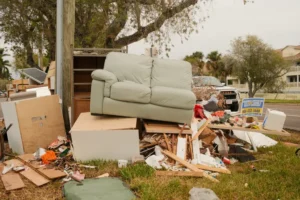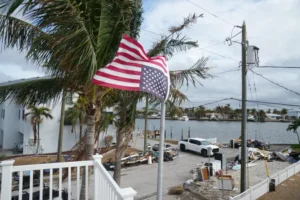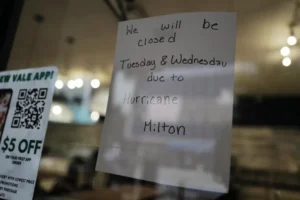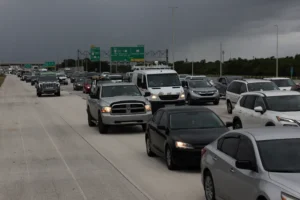As Hurricane Milton moves toward Florida’s Gulf Coast, people are preparing for what experts say could be the worst storm in over 100 years. With huge storm surges and strong winds expected, the region is on high alert, and evacuation orders are being issued.
Hurricane Milton is gaining strength fast, and experts warn it could be one of the most dangerous storms in recent times. Many areas are already vulnerable due to past storms, increasing the risk of widespread damage and flooding.
Evacuation orders are in place, and officials are urging people to take the storm seriously and prepare for life-threatening conditions. Safety is the main focus as the storm approaches, and the next few days will be crucial for those in its path.
### Hurricane Milton: A Record-Breaking Storm
Hurricane Milton has grown into a Category 5 storm, one of the most dangerous types on the Saffir-Simpson scale. With winds over 157 mph, it could cause massive destruction along its path.

The National Hurricane Center warns that homes could be destroyed, trees and power lines will fall, and some places might not be livable for weeks or even months. They said, “A high percentage of framed homes will be destroyed, with total roof failure and wall collapse.”

Storm surges could be especially bad, with water levels rising up to 12 feet in some areas. This could be the worst surge the Tampa Bay area has seen in nearly 100 years. Just weeks ago, Hurricane Helene caused floods with an 8-foot water surge.
Milton is expected to bring even worse flooding. While the storm may weaken to a Category 3 by the time it hits Florida, it will still be dangerous. With winds up to 129 mph, even strong homes could suffer major roof damage, and trees are likely to be uprooted.

Many are comparing Milton to past hurricanes like Irma (2017) and Betsy (1965). But what makes Milton particularly dangerous is the debris left behind by Hurricane Helene, which could worsen the damage.
### Warnings from Officials: The Call to Evacuate
As the hurricane nears, local authorities are giving strong warnings to people in at-risk areas. Tampa Mayor Jane Castor warned, “[If you] stay in one of those evacuation areas, you’re gonna die.”

She said that while past storms like Hurricane Helene were bad, Milton could bring destruction on a whole new level. Pinellas County Sheriff Bob Gualtieri echoed this, calling for the largest evacuation since Hurricane Irma in 2017.
“This is going to be bad. Everyone just needs to get out,” he said. Governor Ron DeSantis also spoke of the risks, saying, “There are areas with a lot of debris… if hit by a major hurricane, it’s going to dramatically increase damage.”

Evacuation orders are in place, and local authorities stress that those who don’t leave will be on their own when the storm hits. Many who stayed behind in past hurricanes are now taking these warnings seriously.
### Evacuation Efforts in Full Swing
With Hurricane Milton approaching Florida’s Gulf Coast, evacuation efforts are in motion. Local authorities have ordered mandatory evacuations for several coastal communities, urging people to leave before it’s too late.

Traffic is heavy on highways as thousands of residents move inland to escape the storm. On Interstate 75, northbound lanes were packed with cars heading toward the Florida Panhandle.
Others sought shelter in places like Fort Lauderdale and Miami, which are expected to be less affected. Meanwhile, southbound lanes were nearly empty. Communities hit hard by past storms aren’t taking chances this time.

In Fort Myers Beach, a town devastated by Hurricane Ian two years ago, streets were empty as residents packed up and left, with only a few people staying behind to secure their homes.
Those who remember the severe flooding caused by Ian’s 15-foot storm surge know the danger is real and are taking steps to avoid a repeat of past tragedies.
As Hurricane Milton nears, people in high-risk areas need to know their evacuation zones and routes. The Florida Division of Emergency Management has a “Know Your Zone” tool, helping residents find their zone by entering their address.

This tool is especially important as evacuation orders continue to come for coastal areas along the Gulf Coast. Several counties are advising residents to check both their evacuation and storm surge zones.
Counties like Hillsborough, Pinellas, Manatee, and Pasco have issued immediate evacuation orders for areas most at risk. Coastal communities in these regions must evacuate quickly.

Other counties, like Polk and Highlands, don’t have mandatory evacuations but recommend sheltering in place. Sarasota, Citrus, and Hernando counties are also monitoring storm surge zones for possible evacuations.
Officials emphasize the importance of knowing your evacuation zone and finding the nearest shelters and safe routes. Those who stay may face the full force of the storm, with emergency services likely unavailable once conditions worsen.

The “Know Your Zone” map offers an easy way for residents to plan their safest escape route. By using this resource and acting quickly, people can protect themselves and their families from Hurricane Milton’s potential devastation.
All the Women in My Family Showed Up to My Wedding Wearing White — What My Fiancée Did Shocked Me

When my fiancée Jen met my tight-knit, prank-loving family, I warned them not to “test” her like they do with every new woman. But on my wedding day, the women arrived grinning in white dresses, defying my ultimatum! Furious, I moved to kick them out — but Jen grabbed the mic and stunned us all.
I never thought my wedding day would turn into a battlefield, but that’s what happens when you come from a family like mine.

A man sitting with his head in his hands | Source: Midjourney
Don’t get me wrong, I love them. But the women in my family? They’re something else entirely.
Picture this: a swarm of aunts, cousins, my mom, stepmom, stepsister, and my grandmother, all bound together by their shared love of what they called “playful teasing.”
The rest of us called it what it was: bullying wrapped in a family tradition bow.
Growing up, I watched them tear through relationships like tissue paper. My cousin Mike’s first girlfriend lasted exactly one family dinner before she excused himself to the bathroom and climbed out the window.

A window in a bathroom | Source: Pexels
My sister-in-law Kelly spent three months crying after every family gathering before she finally “earned her place.”
Even my dad’s second wife, now my stepmom, had to weather six months of subtle jabs and not-so-subtle critiques before they accepted her.
“It builds character,” my mom always said whenever I complained about their antics. “Besides, everyone goes through it. It’s how we know they’re really family.”

A woman speaking during dinner | Source: Midjourney
“More like how you know they’re broken enough to join the club,” I muttered once, earning myself a month of silent treatment.
Their favorite sport? “Testing” any new woman who dared to enter our family circle. They’d pick apart everything from her clothes to her career choices until she either broke down or proved herself worthy.
Then, like some twisted initiation ritual, the victim would usually join their ranks, ready to torment the next newcomer.

Women hugging at a family gathering | Source: Pexels
When I met Jen, I knew she was different. Smart, confident, and kind in a way that made you feel seen.
I also knew my family would eat her alive if given the chance. So when I introduced her, I laid down the law.
“No harassment,” I told them firmly at our first family dinner together. “I mean it. Jen’s off limits.”
They smiled and nodded, all innocent faces and promises. I should have known better.

Women seated at a dinner table | Source: Midjourney
Two weeks later, my cousin Ben showed me the comments they’d left on Jen’s Facebook page. They’d been roasting Jen behind my back, picking apart everything from her “basic” career in marketing to her “try-hard” volunteer work at the animal shelter.
I saw red.
“Delete every last one of those comments on Jen’s Facebook!” I demanded in our family group chat. “Apologize to Jen or none of you are coming to the wedding. Not even Mom! I’m not kidding.”

An angry man typing on his phone | Source: Midjourney
The messages flooded in immediately.
“Oh, come on! We’re just having fun!”
“Don’t be so sensitive.”
“She needs to learn to take a joke.”
“This is how we welcome people into the family. You know that!”
I stood my ground. Eventually, they gave in and apologized, though their words dripped with insincerity. I thought that would be the end of it.
I was wrong.

A thoughtful man staring out a window | Source: Midjourney
Three days before the wedding, my brother Jake called me.
“Listen,” he said, his voice tense. “You need to know something. They’re planning to all wear white to the wedding. They’re calling it a ‘harmless prank’ to test if Jen’s ‘worthy’ of being part of the family.”
My stomach dropped. “Are you serious?”

A concerned-looking man speaking on his cell phone | Source: Midjourney
“Dead serious. Mom’s leading the charge. They’ve got a group chat going and everything. They’ve been shopping together, coordinating their outfits. It’s like some kind of military operation.”
“Of course it is,” I said, rubbing my temples. “Because why would they let my actual wedding get in the way of their power games?”
I immediately sent out a mass text: “Anyone who shows up in white will be turned away at the door. I don’t care if it’s my own mother. This isn’t a joke or a test. It’s my wedding day.”

A man sending an angry text | Source: Midjourney
The responses were immediate and defensive.
“We’d never do that!”
“How can you accuse us of planning to upstage the bride? Shame on you!”
I didn’t believe them for a minute. The night before the wedding, I barely slept, wondering if they’d actually go through with it. Jen noticed my worry but seemed surprisingly calm about the situation.
“Whatever happens tomorrow,” she said, kissing me goodnight, “we’ve got this.”

A woman in bed smiling confidently | Source: Midjourney
On our wedding day, I stationed myself near the entrance, determined to follow through on my threat. When they arrived as a group, my heart nearly stopped.
Every single one of them, from my 70-year-old grandmother to my teenage cousin, was dressed in white. They walked in like they owned the place, smirking and nudging each other.
“You can’t be serious,” I said, stepping in front of them. “I warned you.”

A stern man standing in a building entrance | Source: Midjourney
My sister-in-law, Kelly, laughed. “It’s just a test! If she can’t handle this, she’s not worthy of being part of our family.”
I felt my face growing hot. “Get out. All of you.”
“Now, honey,” my mom started, but I cut her off.
“I mean it. Leave.”
Before I could say another word, I heard feedback from the microphone.

Close up of a microphone | Source: Pexels
My heart stopped as I turned to see Jen standing there, microphone in hand, looking absolutely radiant in her white wedding dress. The room fell silent.
“Before we get started, I’d like to say a few words. As you can see,” she began, her voice steady and clear, “the entire female side of my new family dressed in white today.”
She paused, letting her words hang in the air as the women continued to smirk. None of us were prepared for what she said next.

A bride speaking into a microphone | Source: Midjourney
“I wanted to thank them for supporting my idea to come in white and standing by me during this joyful, but definitely challenging, moment of entering their family,” Jen continued with a smile. “They said they would consider it an honor to back me up, and for that, I am truly grateful.”
The smirks melted off their faces so fast you’d think they’d been slapped. My mom’s jaw actually dropped. Aunt Susan started sputtering, trying to form words. Cousin Rachel turned an interesting shade of pink.
But Jen wasn’t finished with them yet.

A bride smiling while giving a speech | Source: Midjourney
With a graceful movement, she reached for the outer layer of her dress and removed it, revealing a stunning golden gown underneath that seemed to capture every bit of light in the room.
The gasps were audible. In that moment, she was radiant, powerful, and absolutely in control.
Jen smiled impishly as she beckoned to the women. “Come in, ladies, and take your seats so we can get this show on the road!”
I watched as my family members shifted uncomfortably, looking at each other with uncertainty for the first time in my memory. They’d finally met their match, and they knew it.

A group of women wearing white | Source: Midjourney
The mighty had fallen, and they’d fallen hard.
The rest of the wedding was surprisingly peaceful. My family members kept to themselves, speaking in whispers and throwing occasional glances at Jen.
It was like watching a pride of lionesses that had suddenly encountered something they couldn’t intimidate. They were rattled, and more than a little afraid.
Looking back, I realize that moment changed everything.

A smiling man seated at a table | Source: Midjourney
Jen didn’t just outsmart them; she showed them a different way to be strong. She took their power play and turned it into something elegant and kind. No screaming, no threats, just pure class and intelligence.
I’d always known Jen was remarkable, but watching her handle my family with such grace made me fall in love with her all over again.
I’d been ready to fight my entire family for her, something I never thought I’d be capable of doing. But she showed me there were better ways to handle conflict.

A smug woman wearing a gold gown | Source: Midjourney
These days, family gatherings are different. The women still tease, but the cruel edge is gone. They treat Jen with a respect that borders on reverence, and I’ve noticed they’ve stopped “testing” newcomers altogether.
Sometimes I catch them watching her at family events as if trying to figure out how she did it.
As for me? I couldn’t be prouder of my wife. That day, she didn’t just handle a toxic situation; she transformed it.

A couple dancing at their wedding reception | Source: Midjourney
She showed me that sometimes the best way to fight fire isn’t with more fire, but with something unexpected entirely.
“You know,” Jen told me later that night, “I almost wore the gold dress from the start. But then I thought about how they might feel, all dressed up in their white dresses, thinking they had the upper hand.”
I pulled her close. “You’re something else, you know that?”

A couple slow-dancing at their wedding reception | Source: Midjourney
She smiled that brilliant smile that first made me fall for her. “I know. That’s why you married me.”
And she was right. That’s exactly why I married her.
This work is inspired by real events and people, but it has been fictionalized for creative purposes. Names, characters, and details have been changed to protect privacy and enhance the narrative. Any resemblance to actual persons, living or dead, or actual events is purely coincidental and not intended by the author.
The author and publisher make no claims to the accuracy of events or the portrayal of characters and are not liable for any misinterpretation. This story is provided “as is,” and any opinions expressed are those of the characters and do not reflect the views of the author or publisher.



Leave a Reply